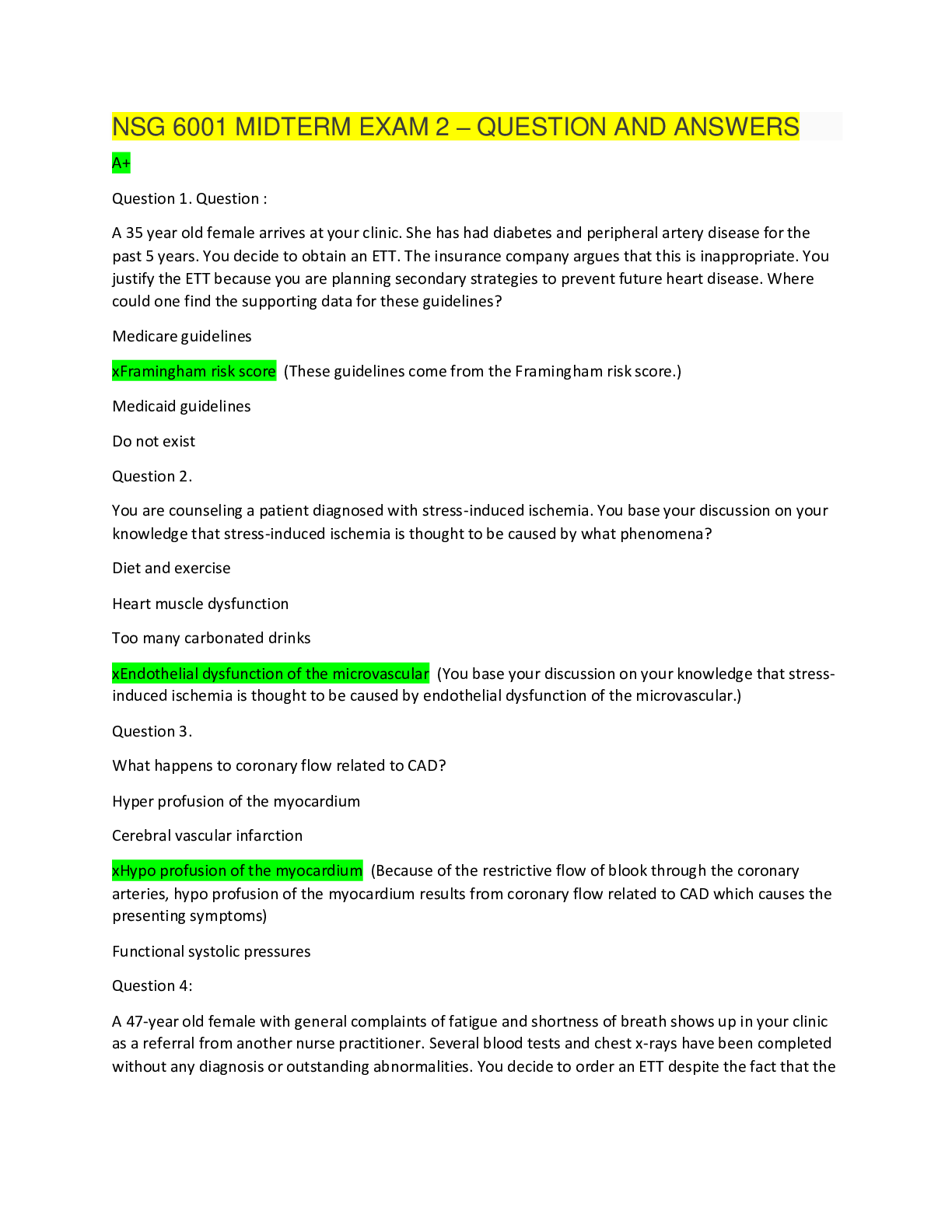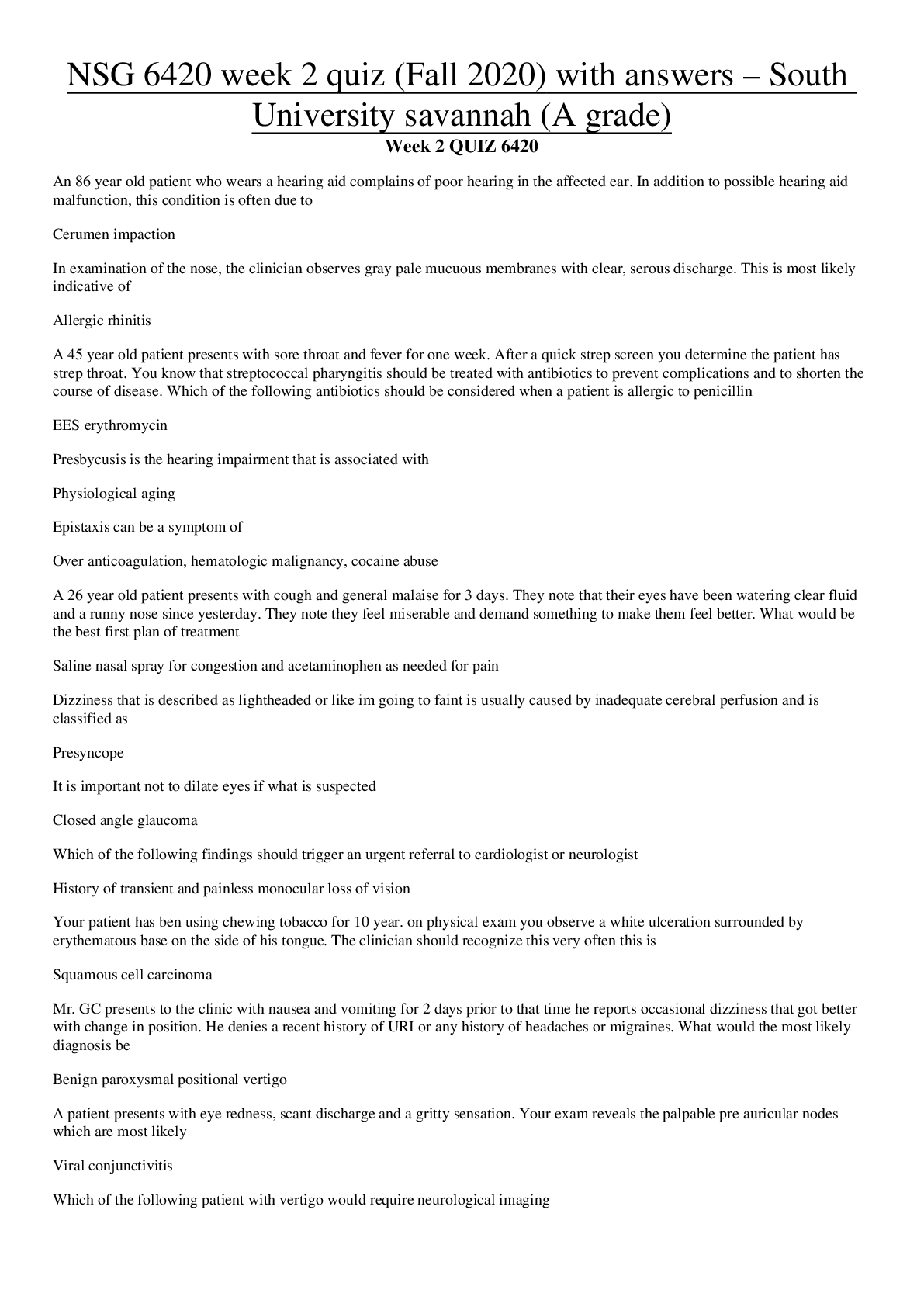NSG 6420 quiz 3 (Fall 2020) with answers – South University (A grade)
Document Content and Description Below
NSG 6420 quiz 3 (Fall 2020) with answers – South University (A grade) NSG6420 QUIZ 3 1. Question : Susan P., a 60-year-old woman with a 30 pack year history, presents to your primary c... are practice for evaluation of a persistent, daily cough with increased sputum production, worse in the morning, occurring over the past three months. She tells you, “I have the same thing, year after year.” Which of the following choices would you consider strongly in your critical thinking process? Student Answer: Seasonal allergies Acute bronchitis Bronchial asthma Chronic bronchitis Instructor Explanation: The pulmonary component includes an abnormal inflammatory response to noxious stimuli, principally tobacco, but also occupational and environmental pollutants. The hallmark of chronic bronchitis is a daily chronic cough with increased sputum production lasting for at least 3 consecutive months in at least 2 consecutive years, usually worse on awakening; this may or may not be associated with COPD (GOLD, 2011). Emphysema is characterized by obstruction to airflow caused by abnormal airspace enlargement distal to terminal bronchioles. Kennedy-Malone, Laurie, Kathleen Fletcher, Lori Martin-Plank. Advanced Practice Nursing in the Care of Older Adults. F.A. Davis Company, 2014-01-14. VitalBook file. (page 206) & Goolsby, Mary J., Laurie Grubbs. Advanced Assessment Interpreting Findings and Formulating Differential Diagnoses, 3rd Edition. F.A. Davis Company, 11/2014. VitalBook file. (page 213) Points Received: 2 of 2 Comments: Question 2. Question : A patient presents complaining of a 5 day history of upper respiratory symptoms including nasal congestion and drainage. On the day the symptoms began he had a low-grade fever that has now resolved. His nasal congestion persisted and he has had yellow nasal drainage for three days associated with mild headaches. On exam he is afebrile and in no distress. Examination of his tympanic membranes and throat are normal. Examination of his nose is unremarkable although a slight yellowish-clear drainage is noted. There is tenderness when you lightly percuss his maxillary sinus. What would your treatment plan for this patient be? Student Answer: Observation and reassurance Treatment with an antibiotic such as amoxicillin Treatment with an antibiotic such as a fluoroquinoline or amoxicillin-clavulanate Combination of a low dose inhaled corticosteroid and a long acting beta2 agonist inhaler. Instructor Explanation: MedU Card #4. According to the American Academy of Ortolaryngology—Head and Neck Surgery Foundation guidelines (2007) on sinusitis, making the distinction between a lingering viral upper respiratory infection that affects the nose and sinuses (viral rhinosinusitis) or early acute bacterial sinusitis can be difficult. It is more likely to be a viral rhinosinusitis if the duration of symptoms is less than ten days and they are not worsening. In this case, you can continue to observe the patient and reassure him that antibiotics are not necessary at this time. Points Received: 2 of 2 Comments: Question 3. Question : Emphysematous changes in the lungs produce the following characteristic in COPD patients? Student Answer: Asymmetric chest expansion Increased lateral diameter Increased anterior-posterior diameter Pectus excavatum Instructor Explanation: In COPD, patients commonly develop a barrel-shaped chest due to emphysematous changes in the lungs. A barrel shape is due to an increased anterior-posterior (AP) diameter. In emphysema, there is a 1:1 ratio of AP to lateral diameter; AP diameter equals the lateral diameter. Normally the AP diameter is twice the lateral diameter. Goolsby, Mary J., Laurie Grubbs. Advanced Assessment Interpreting Findings and Formulating Differential Diagnoses, 3rd Edition. F.A. Davis Company, 11/2014. VitalBook file( page 213-214) & Kennedy-Malone, Laurie, Kathleen Fletcher, Lori Martin-Plank. Advanced Practice Nursing in the Care of Older Adults. F.A. Davis Company, 2014-01-14. VitalBook file. (page 206) Points Received: 2 of 2 Comments: - - - - - - - - Question 18. Question : Your patient has just returned from a 6-month missionary trip to Southeast Asia. He reports unremitting cough, hemoptysis, and an unintentional weight loss of 10 pounds over the last month. These symptoms should prompt the clinician to suspect: Student Answer: Legionnaires' disease Malaria Tuberculosis Pneumonia Instructor Explanation: Many times, patients with active tuberculosis are essentially symptom free. Some complain of malaise and/or fevers but have no significantly disruptive complaints. When respiratory symptoms occur with tuberculosis, cough is common; the cough is nonproductive at first and is later associated with sputum production. Additionally, patients with tuberculosis may experience progressive dyspnea, night sweats, weight loss, and hemoptysis. It is important to suspect tuberculosis when the patient has travelled to a country where TB is endemic, such as Asia. Goolsby, Mary J., Laurie Grubbs. Advanced Assessment Interpreting Findings and Formulating Differential Diagnoses, 3rd Edition. F.A. Davis Company, 11/2014. VitalBook file. (page 217) Kennedy-Malone, Laurie, Kathleen Fletcher, Lori Martin-Plank. Advanced Practice Nursing in the Care of Older Adults. F.A. Davis Company, 2014-01-14. VitalBook file. (page 249) Points Received: 2 of 2 Comments: Question 19. Question : A 76-year-old patient with a 200-pack year smoking history presents with complaints of chronic cough, dyspnea, fatigue, hemoptysis, and weight loss over the past 2 months. The physical exam reveals decreased breath sounds and dullness to percussion over the left lower lung field. The chest X-ray demonstrates shift of the mediastinum and trachea to the left. These are classic signs of: Student Answer: Lung cancer Tuberculosis Pneumonia COPD Instructor Explanation: Dyspnea is the most common symptom associated with pleural effusion, but effusion may be accompanied by cough, pain, and systemic symptoms, such as malaise and fever. Abnormal physical findings become evident as the effusion increases in volume. These include decreased lung sounds, dullness over the effusion, decreased fremitus, egophony, and whispered pectoriloquy. With extremely large effusions, the mediastinum and trachea may shift to the opposite side. The exception involves effusion related to malignancy, in which case the mediastinum and trachea may be pulled toward the malignancy. Goolsby, Mary J., Laurie Grubbs. Advanced Assessment Interpreting Findings and Formulating Differential Diagnoses, 3rd Edition. F.A. Davis Company, 11/2014. VitalBook file (page 217-218) Kennedy-Malone, Laurie, Kathleen Fletcher, Lori Martin-Plank. Advanced Practice Nursing in the Care of Older Adults. F.A. Davis Company, 2014-01-14. VitalBook file.(page 232) Points Received: 2 of 2 Comments: Question 20. Question : A 24-year-old patient presents to the emergency department after sustaining multiple traumatic injuries after a motorcycle accident. Upon examination, you note tachypnea, use of intercostal muscles to breathe, asymmetric chest expansion, and no breath sounds over the left lower lobe. It is most important to suspect: Student Answer: Pulmonary embolism Pleural effusion Pneumothorax Fracture of ribs Instructor Explanation: Pneumothorax involves air in the pleural cavity. A pneumothorax can occur spontaneously in otherwise healthy individuals or be secondary to trauma or intrinsic lung disease. There is history of sudden onset of shortness of breath associated with chest pain. The patient usually presents in great distress, with tachycardia and tachypnea, and is often splinting the chest. There is decreased fremitus and increased hyperresonance on the affected side. Lung sounds are diminished or absent. The trachea may shift away from the affected side if a large pneumothorax is present. [Show More]
Last updated: 2 years ago
Preview 1 out of 24 pages

Buy this document to get the full access instantly
Instant Download Access after purchase
Buy NowInstant download
We Accept:

Reviews( 0 )
$12.50
Can't find what you want? Try our AI powered Search
Document information
Connected school, study & course
About the document
Uploaded On
May 14, 2020
Number of pages
24
Written in
Additional information
This document has been written for:
Uploaded
May 14, 2020
Downloads
0
Views
213








 – University of the People.png)

















